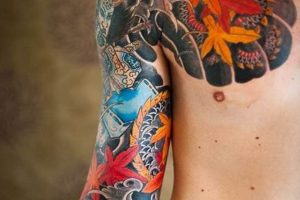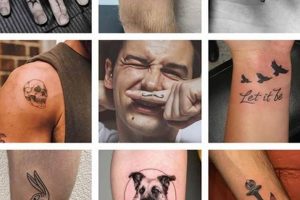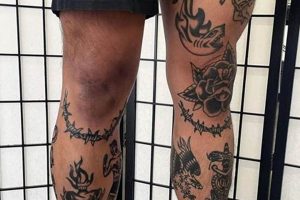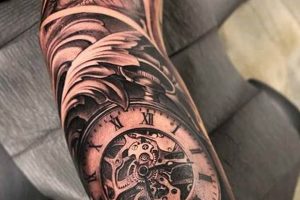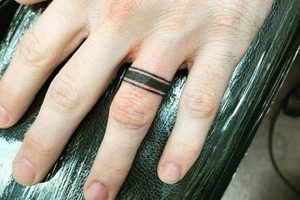Arm tattoos for men represent a popular form of self-expression and body art. They encompass a vast range of styles, imagery, and sizes, from small, minimalist designs to large, intricate sleeves. Examples include tribal patterns, portraits, geometric shapes, nature-inspired elements, and script. The arm’s visibility and varied surfaces the bicep, tricep, forearm, wrist offer ample canvas for artistic exploration.
This body art serves as a powerful medium for communicating personal narratives, beliefs, and aesthetics. Historically, tattoos held cultural and spiritual significance, marking rites of passage, social status, or group affiliation. Today, while retaining some of these traditional connotations, arm tattoos are largely embraced as a form of individual style and a celebration of personal identity. They offer a lasting, visible testament to significant experiences, memories, or passions.
Further exploration of this topic will delve into specific design categories, factors influencing design choices, the tattooing process, and aftercare best practices. It will also address practical considerations such as pain management, cost, and artist selection.
Tips for Arm Tattoos
Careful planning ensures a satisfying and aesthetically pleasing tattoo. Consideration of placement, style, and artist expertise contribute significantly to the final outcome.
Tip 1: Research Tattoo Styles: Explore various styles (e.g., traditional, realism, Japanese, tribal) to determine the aesthetic that best reflects personal preferences and desired imagery.
Tip 2: Consider Placement and Size: The arm offers diverse locations for tattoos. Reflect on visibility preferences (e.g., easily concealed versus prominently displayed) and how the design interacts with the arm’s contours.
Tip 3: Choose a Reputable Artist: Thorough research is crucial. Examine portfolios, review client testimonials, and verify hygiene practices. A skilled artist ensures a high-quality, safe tattoo.
Tip 4: Plan for the Long Term: Tattoos are permanent. Consider the design’s relevance and appeal over time. Avoid impulsive decisions based on fleeting trends.
Tip 5: Prepare for the Process: Ensure adequate rest, hydration, and nourishment before the appointment. Avoid alcohol and blood-thinning medications.
Tip 6: Communicate with the Artist: Open communication is essential. Discuss design ideas, placement, size, and any concerns with the artist to ensure a shared vision.
Tip 7: Follow Aftercare Instructions: Proper aftercare is vital for healing and preserving the tattoo’s vibrancy. Adhere to the artist’s instructions diligently.
By following these guidelines, individuals can navigate the process of obtaining an arm tattoo with confidence, resulting in a piece of body art that is both meaningful and visually appealing.
These considerations provide a foundation for making informed decisions about arm tattoos. The following sections will explore specific design inspirations and practical aspects of the tattooing process.
1. Theme (e.g., nature)
Thematic coherence is a critical element in successful arm tattoo design. A clearly defined theme provides a unifying narrative, ensuring the elements work harmoniously rather than appearing as disparate, unconnected images. Nature offers a rich source of inspiration for masculine arm tattoos. Its diverse elementsanimals, plants, landscapes, celestial bodieslend themselves to a wide array of stylistic interpretations, from realistic depictions to stylized abstractions. A nature theme allows for symbolic representation of qualities such as strength, resilience, growth, and connection to the natural world. For example, a bear might symbolize strength and courage, while a tree could represent growth and resilience.
The chosen theme influences not only the imagery but also other design aspects such as color palette and style. A nature-inspired tattoo might employ earthy tones and organic lines, enhancing the overall aesthetic and symbolic impact. Furthermore, the specific elements within the theme can be personalized to reflect individual experiences and values. A mountain range might represent a love of hiking, while a specific flower could commemorate a loved one. Practical application of a nature theme requires careful consideration of placement and size. Larger, more intricate designs, such as a forest scene, might be better suited for a full or half sleeve, while smaller, simpler elements, like a single leaf or animal paw print, could be effectively placed on the forearm or wrist.
Selecting a cohesive theme, such as nature, provides a framework for creating a meaningful and visually compelling arm tattoo. It allows for personalized expression while ensuring design unity. The chosen theme should resonate with the individual’s values and aesthetic preferences, contributing to a piece of body art that holds lasting significance. This approach fosters a deeper connection between the individual and their tattoo, transforming it from mere decoration into a powerful statement of personal identity.
2. Placement (bicep, forearm)
Placement is a crucial factor in arm tattoo design, influencing visibility, aesthetic impact, and the overall composition. The arm’s diverse canvasbicep, tricep, forearm, wristoffers distinct advantages and challenges. Bicep placement allows for prominent display, showcasing larger designs that benefit from the muscle’s curvature. This location is ideal for bold statements and designs intended for easy visibility. Tribal patterns, animal portraits, and intricate mandalas often find a suitable home on the bicep. However, bicep tattoos can be more challenging to conceal, a consideration for professional environments.
Forearm placement offers greater versatility. The relatively flat surface accommodates a wider range of styles, from detailed portraits to intricate geometric patterns. Forearm tattoos can be readily displayed or concealed depending on sleeve length, making them suitable for individuals seeking more flexibility. Script, smaller symbolic designs, and band tattoos are frequently chosen for the forearm. The wrist, while a smaller canvas, provides a discreet location for minimalist designs, initials, or small symbols. Wrist tattoos are less affected by muscle movement, maintaining their clarity over time. The inner forearm presents a more sensitive area, potentially requiring greater pain tolerance during application.
Strategic placement enhances the tattoo’s visual appeal and symbolic meaning. A design flowing with the natural contours of the arm creates a harmonious, integrated aesthetic. Consideration of visibility preferences and professional requirements guides placement decisions. Understanding the anatomical characteristics of each arm section allows for optimized design choices, maximizing both aesthetic impact and personal significance.
3. Size (half-sleeve, full-sleeve)
Size is a fundamental consideration in arm tattoo design, significantly impacting visual impact, cost, and time commitment. It dictates the level of detail, complexity, and narrative scope possible. Understanding the distinctions between various sizes, particularly half-sleeves and full-sleeves, is essential for informed decision-making.
- Half-Sleeve Tattoos
Half-sleeves typically extend from the shoulder to the elbow or from the elbow to the wrist. This size offers a balance between coverage and flexibility, allowing for moderately complex designs without the extensive commitment of a full sleeve. Half-sleeves can feature a single cohesive theme or a collection of smaller, related designs. They provide ample canvas for detailed artwork while remaining relatively easy to conceal with clothing.
- Full-Sleeve Tattoos
Full-sleeves encompass the entire arm, from shoulder to wrist. This expansive canvas allows for intricate, large-scale designs, often incorporating multiple elements and complex narratives. Full-sleeves represent a significant commitment, requiring multiple sessions and greater investment. They offer maximum artistic expression, allowing for detailed storytelling and visual impact but are difficult to conceal.
- Quarter-Sleeve Tattoos
Falling between smaller designs and half-sleeves, quarter-sleeves typically cover the upper or lower portion of the arm, offering a less extensive option. This size accommodates moderately sized designs or a collection of smaller elements, allowing for a balanced approach to coverage and commitment. They provide a stepping stone for individuals considering larger pieces in the future.
- Smaller-Scale Designs
Individual tattoos or smaller groupings offer focused artistic expression. These designs can be strategically placed on specific areas of the arm, such as the bicep, forearm, or wrist, emphasizing individual elements rather than creating a cohesive sleeve. This approach allows for flexibility and gradual expansion over time, with the potential to incorporate smaller pieces into a larger design later.
Careful consideration of size ensures the tattoo aligns with individual preferences, lifestyle, and desired level of commitment. Choosing the appropriate size allows for optimal realization of the design concept, maximizing its visual impact and personal significance. The chosen size should complement the chosen imagery and the arm’s natural contours, resulting in a harmonious and aesthetically pleasing composition. This balance between size, imagery, and placement is crucial for creating a successful and meaningful arm tattoo.
4. Style (realism, tribal)
Style significantly influences the aesthetic and expressive qualities of arm tattoos for men. Selecting a style aligns the design with personal preferences, cultural influences, and desired visual impact. Understanding the characteristics of various styles allows for informed decisions, ensuring the final tattoo resonates with individual identity and artistic vision. This exploration focuses on key styles frequently chosen for arm tattoos.
- Realism
Realism emphasizes accurate depiction of subjects, often resembling photographs or paintings. Portraiture, animal depictions, and natural scenes benefit from this style’s focus on detail and lifelike representation. Realism requires a skilled artist capable of capturing subtle nuances and textures. Arm placement allows for larger-scale realistic pieces, showcasing the artist’s technical proficiency and the wearer’s appreciation for intricate detail. A realistic portrait of a loved one on the bicep or a detailed animal depiction on the forearm exemplify this style’s potential.
- Tribal
Tribal tattoos draw inspiration from indigenous cultures, incorporating bold lines, geometric patterns, and symbolic imagery. Traditional tribal designs often hold cultural significance, representing lineage, status, or spiritual beliefs. Modern interpretations adapt these elements for personalized expressions of strength, heritage, or connection to nature. The arm’s contours provide an ideal canvas for tribal designs, with flowing lines and geometric shapes accentuating the musculature. A Maori-inspired armband or a Polynesian-influenced half-sleeve exemplifies this style’s adaptability to the arm’s form.
- Japanese
Japanese tattooing boasts a rich history, characterized by vibrant colors, bold outlines, and iconic imagery drawn from folklore, mythology, and nature. Dragons, koi fish, samurai, and cherry blossoms are common motifs, often combined with intricate backgrounds and flowing compositions. Full-sleeve and half-sleeve arm tattoos frequently showcase the dynamic and expressive nature of Japanese style. The arm’s length allows for the depiction of flowing narratives and interconnected imagery, creating a visually captivating and culturally rich piece of art.
- Geometric
Geometric tattoos utilize precise lines, shapes, and patterns to create visually striking designs. This style ranges from minimalist arrangements of simple shapes to complex, interconnected patterns inspired by sacred geometry or abstract art. Geometric designs offer a modern and versatile aesthetic, suitable for various arm placements. A single geometric shape on the wrist, a series of interconnected lines on the forearm, or a complex pattern forming a half-sleeve demonstrate this style’s adaptability.
Choosing an appropriate style enhances the overall impact and meaning of an arm tattoo. The selected style should complement the chosen imagery, personal aesthetic, and desired level of visibility. Consideration of style ensures the tattoo remains a source of personal pride and artistic expression for years to come. Understanding the nuances of each style enables informed collaboration with the tattoo artist, resulting in a piece of body art that reflects individual identity and artistic vision.
5. Color (black and grey, vibrant)
Color selection significantly impacts the aesthetic and emotional resonance of arm tattoos. Careful consideration of color palettes enhances the design’s visual impact, complements the chosen style, and contributes to the overall message conveyed. Understanding the nuances of different color approaches, particularly black and grey versus vibrant color, allows for informed decisions that align with individual preferences and artistic vision. Color choice influences the tattoo’s perceived depth, contrast, and longevity, making it a crucial element in the design process.
- Black and Grey Realism
Black and grey tattoos utilize varying shades of black and grey to create depth, contrast, and a sense of realism. This approach is particularly effective for portraits, animal depictions, and scenes requiring subtle shading and gradation. Black and grey tattoos often evoke a classic, timeless aesthetic, emphasizing texture and form. Skilled artists can achieve remarkable detail and realism using this limited palette, making it a popular choice for intricate arm pieces.
- Vibrant Color Tattoos
Vibrant color tattoos utilize a full spectrum of colors to create bold, eye-catching designs. This approach is well-suited for styles such as Japanese traditional, neo-traditional, and watercolor, where color plays a central role in conveying symbolism and emotion. Vibrant colors can enhance the dynamism of a design, adding depth and visual interest. However, color saturation can fade over time, requiring touch-ups to maintain vibrancy. Careful consideration of colorfastness and long-term maintenance is crucial when choosing vibrant color palettes.
- Color as Symbolism
Color can hold symbolic meaning, adding layers of depth and personal significance to a tattoo. Specific colors can represent emotions, concepts, or cultural references. For example, red might symbolize passion or anger, blue might represent tranquility or sadness, and green might signify growth or nature. Incorporating symbolic color choices can enhance the narrative and emotional resonance of an arm tattoo, creating a more personalized and meaningful piece of art.
- Color and Skin Tone
Skin tone influences how colors appear on the skin. Certain colors may appear more vibrant or muted depending on individual complexion. Consulting with a skilled tattoo artist is crucial for selecting colors that complement skin tone and achieve the desired visual impact. An experienced artist can advise on color choices that will age well and maintain their vibrancy over time, taking individual skin tone into account.
Color selection is an integral aspect of arm tattoo design. The chosen palette significantly impacts the tattoo’s aesthetic, emotional impact, and longevity. Careful consideration of color, in conjunction with other design elements such as style, size, and placement, ensures a harmonious and personally meaningful piece of body art. Collaboration with a skilled artist allows for informed color choices that complement skin tone, enhance the chosen imagery, and achieve the desired visual impact, resulting in a tattoo that resonates with individual identity and artistic expression.
6. Meaning (personal symbolism)
Meaning and personal symbolism are integral to arm tattoo design for men, elevating body art beyond mere aesthetics to powerful expressions of personal narratives, values, and identity. Imbuing a tattoo with symbolic significance creates a deeper connection between the individual and the artwork, transforming it into a permanent reminder of lived experiences, beliefs, or aspirations. Exploring the various facets of personal symbolism provides a framework for creating meaningful and resonant arm tattoos.
- Commemorative Symbols
Commemorative tattoos serve as permanent tributes to significant life events, relationships, or individuals. Dates, names, portraits, or symbolic representations of shared experiences encapsulate lasting memories. A father’s birthdate rendered in Roman numerals, a portrait of a beloved pet, or a symbolic representation of a shared passion, such as a musical instrument or a travel destination, are examples of commemorative tattoos that hold deep personal meaning. Placement on the arm ensures these tributes are readily visible, serving as constant reminders of cherished memories and relationships.
- Representational Imagery
Representational tattoos utilize imagery to symbolize personal qualities, beliefs, or aspirations. Animals, plants, objects, or mythological figures carry inherent symbolic weight, representing concepts such as strength, resilience, growth, or spirituality. A lion might symbolize courage and leadership, a tree might represent growth and resilience, a compass might signify guidance and direction, and a religious icon might express faith and devotion. These symbolic representations allow individuals to externalize core values and aspirations, transforming the arm into a canvas for self-expression.
- Cultural or Spiritual Symbols
Cultural or spiritual symbols connect individuals to their heritage, beliefs, or spiritual practices. Tribal patterns, religious iconography, or symbols derived from specific cultures hold deep-rooted significance, representing lineage, faith, or connection to a larger community. A Maori-inspired spiral pattern, a Buddhist mandala, or a Celtic knotwork design exemplifies the use of cultural or spiritual symbols in arm tattoos. These symbols serve as visible expressions of identity, heritage, and spiritual connection.
- Abstract or Geometric Designs
Abstract or geometric designs can hold personal meaning derived from their form, composition, or the individual’s interpretation. Specific shapes, patterns, or combinations thereof can represent abstract concepts, emotions, or personal experiences. A series of interconnected lines might represent interconnectedness, a spiral might symbolize growth and transformation, and a geometric pattern might represent order and balance. The meaning of abstract designs often remains open to interpretation, allowing for a deeply personal and evolving connection between the individual and the tattoo.
Integrating personal symbolism into arm tattoo designs transforms them from decorative elements into powerful statements of identity and personal narratives. Careful consideration of symbolic meaning elevates the tattoo’s significance, creating a lasting connection between the individual and the artwork. This intentional approach to design ensures that arm tattoos serve not only as aesthetic enhancements but also as meaningful expressions of personal values, experiences, and aspirations.
7. Artist Specialization
Artist specialization plays a crucial role in realizing successful arm tattoo designs for men. The diverse landscape of tattoo stylesrealism, traditional, Japanese, geometric, and moredemands specific skill sets and artistic sensibilities. Selecting an artist specializing in the desired style significantly impacts the final outcome, ensuring technical proficiency, stylistic accuracy, and overall aesthetic coherence. A client envisioning a photorealistic portrait benefits from an artist specializing in realism, possessing mastery of shading, texture, and anatomical accuracy. Conversely, a tribal-inspired design requires an artist versed in the specific cultural nuances, symbolism, and traditional techniques of that style. Choosing a specialist mitigates the risk of stylistic inaccuracies, technical flaws, and ultimately, an unsatisfactory result.
Practical implications underscore the importance of artist specialization. An artist specializing in black and grey realism possesses a nuanced understanding of tonal gradation, depth creation, and achieving lifelike representation using a limited color palette. Their portfolio likely showcases a body of work demonstrating expertise in this specific area. Similarly, an artist specializing in Japanese traditional tattooing understands the cultural significance of specific motifs, the traditional application techniques, and the dynamic interplay of color and composition characteristic of this style. Their portfolio demonstrates proficiency in bold linework, vibrant color palettes, and the depiction of iconic Japanese imagery such as dragons, koi fish, and samurai. Choosing an artist with a demonstrable track record in the desired style ensures the design is executed with technical precision and stylistic authenticity. This informed selection process maximizes the likelihood of a successful outcome, resulting in a high-quality, aesthetically pleasing, and personally meaningful arm tattoo.
Effective execution of complex arm tattoo designs hinges on artist specialization. Selecting an artist with proven expertise in the desired style ensures stylistic accuracy, technical proficiency, and a final result that aligns with the client’s vision. Understanding the nuances of various tattoo styles and recognizing the importance of specialized skill sets are crucial for making informed decisions in the artist selection process. This careful consideration contributes significantly to the creation of a high-quality, aesthetically pleasing, and personally resonant arm tattoo that will stand the test of time.
Frequently Asked Questions
This section addresses common inquiries regarding arm tattoos for men, providing concise and informative responses to facilitate informed decision-making.
Question 1: How does one determine the right tattoo style and design?
Thorough research, introspection regarding personal aesthetics, and consultation with experienced tattoo artists are crucial for selecting appropriate styles and designs. Examining portfolios, exploring online resources, and engaging in open communication with artists contribute to well-informed choices.
Question 2: What factors influence the cost of an arm tattoo?
Size, complexity, artist’s experience and reputation, studio location, and session duration influence tattoo costs. Larger, more intricate designs requiring multiple sessions by renowned artists in prime locations typically incur higher costs.
Question 3: What is the typical healing time for an arm tattoo?
Healing typically requires 2-4 weeks, depending on individual factors, tattoo size, and placement. Adherence to aftercare instructions provided by the artist is crucial for proper healing and optimal aesthetic outcomes.
Question 4: Are there specific design considerations for different arm placements (bicep, forearm, wrist)?
Design choices should complement the arm’s natural contours and consider visibility preferences. Bicep tattoos often feature larger, bolder designs, while forearm tattoos offer greater versatility. Wrist tattoos are generally smaller and more discreet.
Question 5: How can one ensure they choose a reputable and skilled tattoo artist?
Thorough research involving portfolio reviews, client testimonials, and verification of hygiene practices is essential. Consulting with multiple artists and seeking recommendations from trusted sources can also inform the selection process.
Question 6: Can arm tattoos be removed or covered up?
Laser removal can fade or eliminate tattoos, but complete removal is not always guaranteed and can be costly and time-consuming. Cover-up tattoos are an alternative, but design options are limited by the existing tattoo.
Careful consideration of these frequently asked questions empowers individuals to make informed decisions regarding arm tattoos, ensuring a positive and fulfilling experience. Addressing these common concerns promotes realistic expectations and fosters a collaborative relationship between the client and the tattoo artist.
The following section will provide practical tips for preparing for a tattoo appointment and navigating the aftercare process.
Conclusion
Exploration of arm tattoo design for men reveals a complex interplay of artistic expression, personal symbolism, and technical expertise. Careful consideration of theme, placement, size, style, color, and individual meaning ensures a cohesive and personally resonant result. Artist specialization is paramount, guaranteeing technical proficiency and stylistic accuracy. Informed decision-making, grounded in research and consultation with experienced professionals, mitigates potential risks and maximizes the likelihood of a successful outcome.
Arm tattoos offer a powerful medium for self-expression, allowing men to externalize narratives, values, and aspirations. Choosing a design that aligns with individual identity and aesthetic preferences ensures a lasting source of personal pride. The permanence of tattoos underscores the importance of thoughtful consideration, emphasizing the collaborative nature of the process between client and artist. This collaborative approach results in body art that transcends mere decoration, becoming a powerful statement of personal identity and artistic expression.



